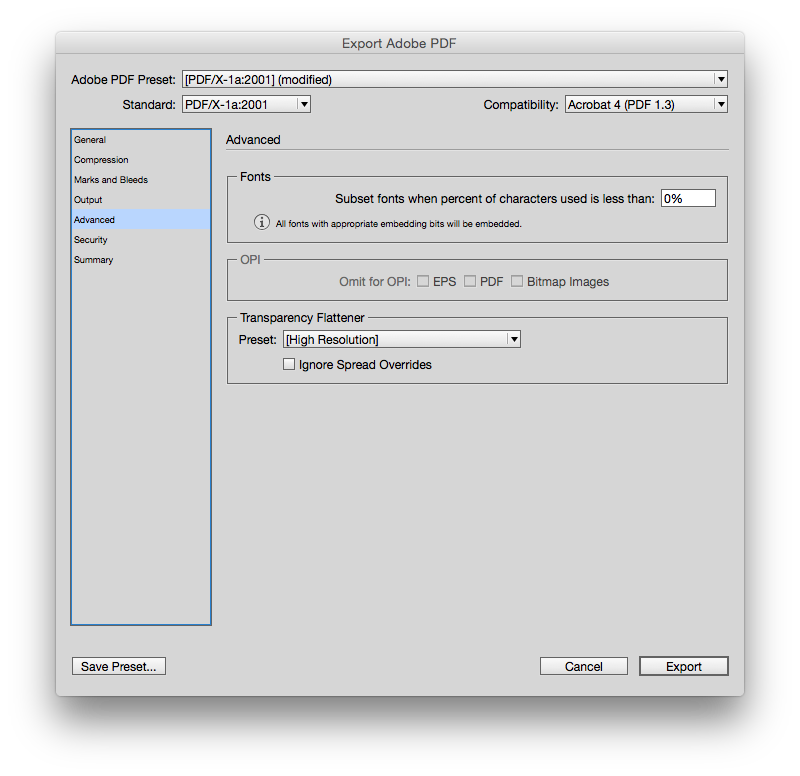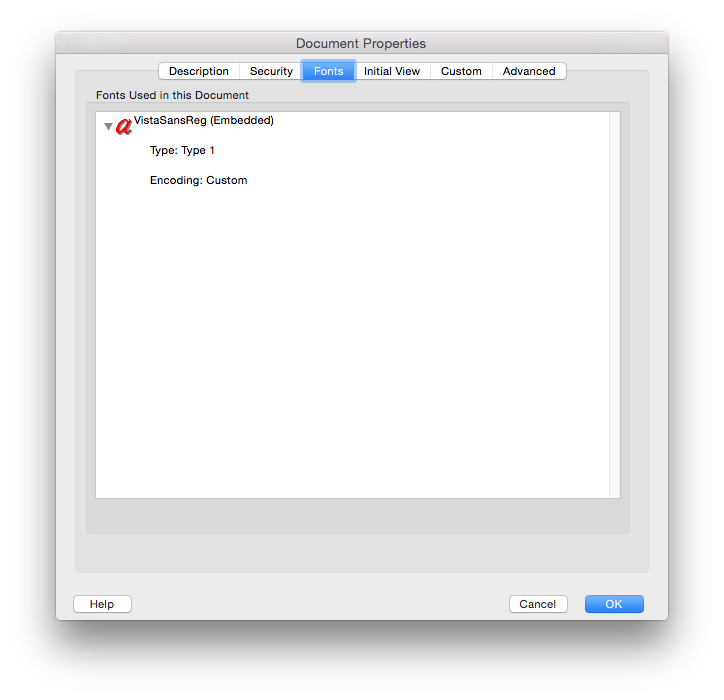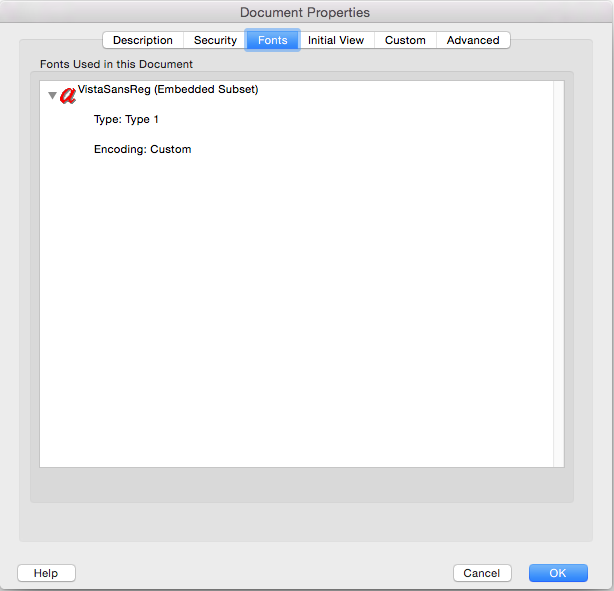Copy link to clipboard
Copied
Hi,
I had a piece of information but I can't seem to find it anymore so I have to ask ...
This is about understanding limitations of fully embedding fonts in a PDF (from Indesign Server). Actually it's about one limitation in particular. I know fonts with licensing issues or fonts that are marked "embedded not allowed" will not be embedded. Also, there is a threshold that I need to set.
So, I recall reading somewhere that Indesign will not fully embed "standard" fonts. Is that correct and what is this standard fonts category?
Oh, reading through some posts, I noticed lots of people and experts ask why does one need fully embedded fonts. That's a good question and I don't know the root reason but in my case it seems that some regulatory agencies (in the life sciences/pharma domain) require PDFs with fully embedded fonts.
Many thanks
Cristian
 1 Correct answer
1 Correct answer
On behalf of Adobe:
(1) For both InDesign “PDF export” (including InDesign Server) and Illustrator “save as PDF” functions, most but not all of the .joboptions file font embedding options are totally and utterly ignored. The options that are ignored are the Embed all fonts, Embed OpenType fonts, Always embed, and Never embed. Those options are observed by Distiller and the PDFMaker components of Acrobat.
(2) These applications will attempt to embed all fonts referenced by the document, reg
...Copy link to clipboard
Copied
You may be mixing some memories.
The Standard PDF .joboptions setting does not embed common fonts.
InDesign's Export ignores these this attribute. (Other means of pdf creation will honor the "not embed")
I recall reading somewhere that you can force a full Embed without subset if you set the threshold to 0. InDesign will allow 0 in the subset minimum, Distiller requires 1-100 as input.
Distiller shown
You
Copy link to clipboard
Copied
Thanks Daniel!
If you're suggesting I mixed "standard fonts" with "standard options", the answer is 'no'. I am not saying my memories don't have bad sectors, just not that one. I am pretty sure I recall reading about "standard fonts". I actually never saw the options above. But maybe you did answer my question ...
And to clarify I am talking about Indesign Server and associated Javascript APIs. I posted the question on this forum assuming the functionality would be generic. And yes, I do use the threshold at 0 if I want full embedding
Copy link to clipboard
Copied
There are 14 fonts with a special status: Helvetica (regular, oblique, bold, bold oblique), Courier (ditto), Times (roman, italic, bold, bold italic), Symbol and Zapf Dingbats. (These privileges do not extend as some believe to similarly named fonts). These fonts never need to be embedded because they can always be shown. But they can be embedded, assuming you own them.
There is a separate problem with embedding entire fonts: most fonts now CANNOT be fully embedded. I think this is true of all OpenType fonts but cannot confirm it. Some agencies indeed have unhelpful requirements which cannot necessarily be satisfied.
Copy link to clipboard
Copied
On behalf of Adobe:
(1) For both InDesign “PDF export” (including InDesign Server) and Illustrator “save as PDF” functions, most but not all of the .joboptions file font embedding options are totally and utterly ignored. The options that are ignored are the Embed all fonts, Embed OpenType fonts, Always embed, and Never embed. Those options are observed by Distiller and the PDFMaker components of Acrobat.
(2) These applications will attempt to embed all fonts referenced by the document, regardless of the settings of the .joboptions file. The only reason why a font would not be embedded in a PDF file would be if (a) the font was unavailable (i.e., not installed on the system) or (b) the font's embedding permissions do not permit embedding for at least preview and print privileges. Thus, if you use the so-called Standard .joboptions (strongly not recommended for any graphic arts purposes), even the base 14 fonts (four faces each of Helvetica, Times, and Courier along with Symbol and ITC Zapf Dingbats will be embedded if your document references them.
(3) The subset threshold value of 0 (zero) may effectively cause all the glyphs of a font to be embedded in some, but not all cases. This will work for many if not most Type 1 fonts and some smaller TrueType and OpenType CFF fonts. Note that embedding all glyphs in a font is not the same as embedding a full font. For OpenType and TrueType fonts, InDesign and Illustrator never embed all the tables of the font. Such unembedded tables include those used for pair kerning, advanced OpenType features (such as ligatures, alternate representations, contextual alternates, small caps, old style figures, etc.), and extended metrics.
(4) There are plenty of bubbameissas out there with regards to the benefits or liabilities of either fully embedding or subset embedding fonts. What is true is that: (a) Acrobat never uses the embedded font for text editing - you must have the font installed on the system in order to do such edits. (b) Subset embedding or not is totally irrelevant to what a RIP does when rendering text, either for PostScript or direct PDF RIPs. Neither subset or full embedding is any more reliable than the other and the specifications of PostScript and PDF do not permit the RIP to replace the embedded font with a font with a similar name - urban legend notwithstanding!!!! (c) Third party plug-ins to Acrobat or applications that claim to allow you to edit PDF files with embedded fonts may be illegally letting you do so if the embedding permissions do not permit embedding for editable embedding or installable embedding - most fonts do not provide such embedding permissions and since the fonts are missing metric information, such editing may be somewhat lacking in quality or features.
(5) In fact some very non-tech-savvy organizations have posted requirements for full embedding of fonts in submitted PDF files (I have personally seen one such requirement by some international bureaucracy). They can post such bone-headed requirements based on limited understanding of PDF and PDF workflows, but that doesn't mean that anybody actually provides such PDF files. If in fact you run into such requirements, I would appreciate it if references to same can be forwarded to my attention by private message on these forums.
- Dov
Copy link to clipboard
Copied
Dov - can you define "bubbameissas" please!
Copy link to clipboard
Copied
DerekC1000 wrote:
Dov - can you define "bubbameissas" please!
Yiddish for “grandmother's tales” somewhat akin to unsubstantiated urban legends perpetuated over the years. Somewhat difficult to really translate.
- Dov
Copy link to clipboard
Copied
Thanks. I couldn't find it via Google. The things you learn on this forum are amazing!
Copy link to clipboard
Copied
@Dov, thanks for the clarifications!
Just want to make sure I got it right.
On (2) you are referring on embedding in general, not necessarily full/all glyphs/subset. So, when you say "even the base 14 fonts ... will be embedded ...", you don't necessarily mean all glyphs/full ...
On (3) you mention that " threshold value of 0 may effectively cause all the glyphs of a font to be embedded in some, but not all cases ... This will work for many if not most Type 1 fonts and some smaller TrueType and OpenType CFF fonts".
Is there a way for me to tell which fonts (or why) will not have all their glyphs embedded in the context of exporting to PDF from Indesign Server and a threshold of 0 ? (i.e. of course, this excludes the licensing issues or physical presence of fonts)
-Cristian
p.s. I am trying to do some testing but my Server version 10 expired and the only CC server version I have is 9, not compatible with the CC client v 10. And I have a feeling the IDML format might explain some of issues I see with font embedding ...
p.s. 2 I am not sure what agencies ask for this as I don't deal with them directly (as a customer). I heard they are in Europe.
Copy link to clipboard
Copied
If you are exporting PDF, then all fonts are embedded. The only thing you can control is subsetting, based on percentage used value.
If you are writing Postscript and Distilling, then you can control embedding. In the postscript, it's complete, none or subset. In Distiller, you can control specific fonts to be always or never embedded.
If you are exporting, this is a moot point.
Copy link to clipboard
Copied
PDFs should alway be created via Export PDF, not with printing and Distiller, avoid it as it needs postscript. Postscript does neither support color management nor transparency, that's why you should avoid Distiller, Postscript and EPS.
Copy link to clipboard
Copied
To reinforce Willi's response, Adobe most strongly recommends against any PDF creation from InDesign, Illustrator, or Photoshop via distillation of PostScript! The PostScript generated by these programs is optimized for direct printing, not creation of a PDF file. The resultant PDF file loses all live transparency as well as color management.
- Dov
Copy link to clipboard
Copied
Hi Dov,
How to change the
Fully embedding fonts in pdfExportPresets
Fully embedding fonts in PDF
Can you share how to change using via javascript.
hi team,
Please share sample code.
Copy link to clipboard
Copied
The JS API lets you control subsetting via .subsetFontsBelow, but you wouldn't be able to embed a font that doesn't allow embedding via the GUI or scripting.
Here are the PDFExportPreference parameters:
Copy link to clipboard
Copied
curela wrote:
@Dov, thanks for the clarifications!
Just want to make sure I got it right.
On (2) you are referring on embedding in general, not necessarily full/all glyphs/subset. So, when you say "even the base 14 fonts ... will be embedded ...", you don't necessarily mean all glyphs/full ...
On (3) you mention that " threshold value of 0 may effectively cause all the glyphs of a font to be embedded in some, but not all cases ... This will work for many if not most Type 1 fonts and some smaller TrueType and OpenType CFF fonts".
Is there a way for me to tell which fonts (or why) will not have all their glyphs embedded in the context of exporting to PDF from Indesign Server and a threshold of 0 ? (i.e. of course, this excludes the licensing issues or physical presence of fonts)
-Cristian
p.s. I am trying to do some testing but my Server version 10 expired and the only CC server version I have is 9, not compatible with the CC client v 10. And I have a feeling the IDML format might explain some of issues I see with font embedding ...
p.s. 2 I am not sure what agencies ask for this as I don't deal with them directly (as a customer). I heard they are in Europe.
With regards to (2), you are correct that I don't mean all glyphs.
With regards to (3), there is no guaranteed method of determining this.
- Dov
Copy link to clipboard
Copied
Dov,
I have read your response Dec 6, 2014 11:01 PM (in response to curela), and so send the following request for help.
I am a small publisher who has submitted and printed successfully PDF files with a demand printing house. Now I am adding another printer/retailer. When I submit my PDFX-1s (SWOP) file to them for validation, they respond that they are unable to process files with the following issue: "FONTS CONTAIN MISSING GLYPHS OR ARE NOT FULLY EMBEDDED IN THE PDF*: We require that all fonts be embedded, with no missing glyphs. Please submit a new file with all fonts properly embedded. Saving a file using the default PDF/X-1a:2001 setting will eliminate this issue. You may refer to the File Creation Guide for further instructions on creating a compliant PDF."
Question, do they have a problem or is there something I am missing (or miss-using) in Acrobat Pro? I am running on version 11.0.13.
Thanks in advance for your anticipated help.
Rex Krueger
[personal information removed per policy - https://forums.adobe.com/docs/DOC-3731]
[This is an open forum, not Adobe support, please do not post personal information]
Copy link to clipboard
Copied
FONTS CONTAIN MISSING GLYPHS OR ARE NOT FULLY EMBEDDED IN THE PDF*
If the printer is not allowing subsetting than you can set Subset fonts when... to 0%. The default is 100%.

In Acrobat's Document Properties you should see the difference:
0%

The default 100%:

Copy link to clipboard
Copied
Hello Mr Dov Issacs, I am a graphic design at LaSalle College in Vancouver. In one of our technical classes a professor argues that if a font is not embedded 100% it will not be printable as offset printing. I tried a bunch of different fonts but none of them will embed 100% and will always show as "subset". Is there anyway I could reach our to you by email? I am hoping that your explanation above can help us find a common ground regarding font embedding.
Thank you
Nazeem
Copy link to clipboard
Copied
Hi @Nazeem.J, Dov Isaacs has retired from Adobe.
And this thread is very old, going back 9 years ago to 2014. Things might have changed since then.
Your professor has some of the information correct.
For printing, the font must be embedded into the PDF, but it CAN be subsetted. The usual setting is:
- Subset fonts when percent of characters used is less than: 100%.
This means that if you didn't use all the glyphs in each font (which could be several thousand for each font), only those glyphs that were used in your layout will be embedded in the PDF. And that's sufficient to print the document at your print shop.
At some print shops, they might need to actually have those fonts installed on their prepress computers to output the file, in addition to the fonts being embedded in the PDF. But that's their system's requirements.
Here's a very typical press setting; of course, you could also select a different preset (PDF/X4, for example) but the fonts setting is still the same.
Hope this helps!
| PubCom | Classes & Books for Accessible InDesign, PDFs & MS Office |
Copy link to clipboard
Copied
Thank you for all the informations provided. From several tries in Indesign, even if I set the "subset fonts when percent of characters used is less than" to 0 it will still show the font as not fully embedded in acrobat preflight. I also when to ask regarding Type 1 fonts. Is there such thing that Type 1 fonts are not good for printing? In Adobe fonts lots of the fonts comes as Type 1. That you again for your time and explanations. Appreciate it.
Copy link to clipboard
Copied
"subset fonts when percent of characters used is less than" to 0 it will still show the font as not fully embedded in acrobat preflight.
By @Nazeem.J
Yes, with the value is set to "0" (zero), no fonts will be embedded.
That's why you don't set it to 0. Set it to "less than 100%" to force the fonts to be subsetted and embedded.
Type 1 fonts are fine for printing, but fully OpenType (Unicode) fonts are preferred because they contain a larger set of characters, conform to the industry standards set in 2000, and give designers more options.
When a PDF is exported, the system will record the font as "Type 1" in the PDF, even it if is an OpenType font. That's because there are 2 "flavors" of OpenType fonts: those built on TrueType encoding and those built on PostScript encoding.
Can you give us a screen capture of the report that shows that fonts were not embedded?
I also when to ask regarding Type 1 fonts. Is there such thing that Type 1 fonts are not good for printing? In Adobe fonts lots of the fonts comes as Type 1.
Adobe no longer sells or distributes Type 1 fonts. In 2000, the entire computer industry converted to OpenType/Unicode fonts and Adobe's font library was converted then, too.
Where are you seeing Type 1 fonts?
- In your InDesign font menus?
- In your font manager, such as FontBook on the Mac?
- In the Properties dialogue of the font file itself?
- In an Acrobat Preflight report?
| PubCom | Classes & Books for Accessible InDesign, PDFs & MS Office |
Copy link to clipboard
Copied
Yes, with the value is set to "0" (zero), no fonts will be embedded.
That's why you don't set it to 0. Set it to "less than 100%" to force the fonts to be subsetted and embedded.
@Bevi Chagnon - PubCom.com I think you have this wrong. What Dov said, and I believe correctly, is:
"(3) The subset threshold value of 0 (zero) may effectively cause all the glyphs of a font to be embedded in some, but not all cases. This will work for many if not most Type 1 fonts and some smaller TrueType and OpenType CFF fonts. Note that embedding all glyphs in a font is not the same as embedding a full font. For OpenType and TrueType fonts, InDesign and Illustrator never embed all the tables of the font. Such unembedded tables include those used for pair kerning, advanced OpenType features (such as ligatures, alternate representations, contextual alternates, small caps, old style figures, etc.), and extended metrics."
Copy link to clipboard
Copied
I triend using diferrent values (0, 1, 99, 100) and the when doing a preflight check in Acrobat I will always get that the font is "embedded as a subset". Like a Peter Spier mentioned previously I also believe that "InDesign and Illustrator never embed all the tables of the font". See screetshot of my preflight setting as well as results.
Copy link to clipboard
Copied
There should be zero concern about any of this. Your professor was wrong...FULL STOP!
Any modern service provider should be able to print a PDF exported from InDesign with fonts subsetted. I would go back to that "professor" and point him/her to this conversation and ask for clarification of that statement.
Copy link to clipboard
Copied
One thing that doesn't seem to have been mentioned is the subtle difference between "embed all fonts" and "fully embed fonts." It's important for output that every font used in the file be embedded with a subset to cover the used glyphs or be installed previously in the exact same version on the output device. I suspect many places that write a spec for fully embedded fonts don't understand the difference and really mean embed all fonts.
-
- 1
- 2
Find more inspiration, events, and resources on the new Adobe Community
Explore Now




